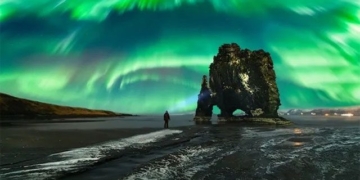A blast occurring 3 billion light-years from Earth has generated enough heavy metals to exceed the total mass of all the planets, moons, and asteroids in the Solar System combined.
In 2021, the Neil Gehrels Swift Observatory detected the merger of two dense celestial bodies known as a kilonova and designated it as GRB 211211A. This is the most recent example of this rare astronomical event that humans have not detected alongside gravitational waves. GRB 211211A is particularly unusual because the gamma-ray burst (GRB) it produced lasted for a full minute. Previously, such durations were only associated with GRBs from supernova explosions rather than neutron star mergers.

Simulation of the gamma burst GRB 211211A. (Photo: Soheb Mandhai/ @TheAstroPhoenix)
Four studies published simultaneously in the journal Nature describe the findings and the processes that could lead to such an event, reported IFL Science on August 15. However, the most intriguing aspect of the event is perhaps the astonishing amount of heavy elements produced by the explosion, including precious metals like gold and platinum.
“We found that this event produced a mass of heavy elements approximately 1,000 times that of Earth. This supports the hypothesis that kilonova explosions are the primary factories of gold in the universe,” said Dr. Matt Nicholl from the University of Birmingham.
Ordinary stars fuse hydrogen into helium, then convert helium into other elements throughout their lifetimes. Upon dying, low-mass stars generate some new materials, but most heavy elements require a more violent birth process. Elements like aluminum and potassium form in supernova explosions, but astronomers suspect there is another source of heavy elements since the number of supernovae they have encountered does not correlate with their abundance.
When neutron stars merge, the energy they release leads to the formation of a significantly larger amount of heavy metals than supernova explosions. Although kilonovae are considerably rarer than supernovae, they produce more heavy elements and account for a large portion of the heavy metals present in the universe. Consider that the Sun has a mass 330,000 times that of Earth, and 99.5% of the Earth’s crust contains elements no heavier than iron. This underscores the scale of the “gold factory in the universe.”
To understand what events like GRB 211211A contribute to the existence of heavy elements in the universe, researchers need to know their prevalence. Other long GRBs have been detected separately without accompanying supernova explosions, but they cannot be certain if the cause was a kilonova explosion. The research community is still exploring what triggered GRB 211211A. One hypothesis is the merger of a neutron star with a white dwarf instead of two neutron stars.





















































